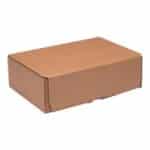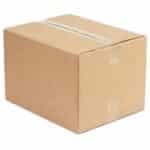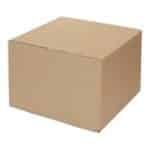Use the dimensional weight calculator above to determine the DIM weight of any parcel. Follow the steps by entering your parcel’s outside dimensions. For irregular packaging, measure from the widest points.
DIM Weight: Overview
Dimensional weight, also called DIM weight, is a pricing formula shipping companies use to determine shipping rates based on a parcel’s volume. If your business ships regularly, understanding how dimensional weight affects your bottom line is crucial to your success since there is a risk for bigger shipping fees—large and lightweight parcels cost more to ship than small and heavy parcels.
This article shows you how to calculate the dimensional weight of your packages, explains DIM pricing and when it applies, and gives tips for shipping your parcels.
How DIM Weight Works
Dimensional weight represents the amount of space your parcel occupies in relation to its actual weight.
Space is a prime commodity for shipping carriers since each truck has limited room for packages, and this is where DIM weight comes into play. By calculating a package’s dimensional weight, carriers are able to charge for the amount of space a parcel will take up without relying solely on its weight.
Dimensional Weight Formula
The formula for calculating a parcel’s dimensional weight involves multiplying the package’s length, width, and height, and then dividing the product by the carrier’s dimensional factor (DIM factor)—which is 139 (for FedEx and UPS Daily Rates) or 166 (for USPS and UPS Retail Rates).
Dimensional Weight = Package (Length x Width x Height) / Carrier DIM Factor*
FedEx and UPS Daily Rates: 139; USPS and UPS Retail Rates: 166
UPS Daily Rates are lower and offered to frequent shippers with a UPS account.
UPS Retail Rates are usually higher and intended for occasional or low-volume shippers.
The carrier uses a different DIM factor for each of these two rates.
DIM Weight vs Billable Weight
Carriers consider two weights—your package’s actual weight and DIM weight—and calculate shipping fees based on whichever is greater. This greater value is called the billable weight.
If the actual weight of your package is greater than the dimensional weight, DIM weight does not apply. For example, if your package weighs 9 lbs. and its calculated DIM weight is 8 lbs., your package will be billed according to its actual weight (because it is greater).
UPS and FedEx factor in dimensional weight to calculate shipping rates for all domestic and international shipments.
USPS, on the other hand, only uses dimensional weight for packages that fit all of the following criteria:
- Shipping via Priority Mail or Priority Mail Express
- Larger than 1 cubic foot (or 1,728 cubic inches)
- Shipping to Zones 5–9 based on your location (see your USPS Zone Chart here)
Additionally, DIM weight does not apply to USPS Priority Mail International items.
Now that you know how major shipping carriers calculate their respective DIM weights, you can dig in deeper by reading FedEx vs UPS vs USPS comparison guide for small businesses to help you decide which carrier to use.
Impact of DIM Weight on Shipping Rates
If you generally ship small and heavy packages, you don’t need to worry about DIM weight-based shipping rates. Carriers have a straightforward shipping calculator that calculates rates based solely on your package’s actual weight.
However, if your products are relatively light but need to be shipped in a large box, you may pay more than you usually expect due to DIM weight pricing. This is because larger parcels allow for fewer units to fit in a single truckload, so they are more expensive to ship than small, heavy parcels.
If your business ships regularly, understanding how dimensional weight affects your bottom line is crucial to your success. Because of DIM pricing, you can dramatically overpay when shipping if you aren’t careful about your packaging choices.
For instance, take a look at the table below to see the difference in shipping rates the following boxes have even if they weigh the same.
Box Type |  |  |  |
Dimensions | |||
| Actual Weight | 3 lbs. | 3 lbs. | 3 lbs. |
Dimensional Weight (UPS and FedEx) | 1 | ||
Billable Weight (Greater value of the two) | |||
Ground Shipping Cost (Houston to NYC) | $18.59 | $20.85 | $45.14 |
As you can see, the size of your packaging greatly impacts your shipping costs due to dimensional pricing.
TIP: Compare the DIM weights of different box options to determine the most cost-effective packaging for the items you ship.
Tips for Ecommerce Shipping
With dimensional pricing in mind, here are six ways to minimize your shipping spend, increase your bottom line, and get orders out to customers faster:
Consider Product Size
In today’s competitive ecommerce environment, charging customers the actual cost of shipping usually leads to abandoned carts and lost sales. So you’ll likely have to find ways to offer free shipping on your products—which may mean absorbing some of the shipping costs on large products.
In these cases, large and low-cost goods might not yield enough profit to cover your losses.
Plus, you have to get those goods into your fulfillment warehouse and then ship them to your customers—which can be costly since DIM weight usually applies to both inbound and outbound shipments.
Ultimately, the overall packed size of a product is something you must consider when sourcing wholesale goods or manufacturing your own.
Choose Packing Materials Wisely
Now that you understand how DIM weights impact the price you pay for every parcel you ship, it’s time to closely scrutinize the boxes and mailers you use.
If you’re a budget-conscious small business or startup, your goal is to use the smallest box (or envelope, flat, or tube) needed to protect your item in transit. Anything more than that will cut into your bottom line.
Plus, too-large packaging requires excessive packing materials to fill the void, which adds costs. Using appropriate packaging to ship your products is an easy way to cut wasteful spending on fill materials and shipping rates.
Consider Custom Boxes
If you ship in volume and find that ready-made boxes aren’t a perfect fit for your items, custom-made boxes can help you save on shipping in the long run. This is especially true for shipping large items—like furniture or musical instruments.
For small items that ship in boxes less than 16”x16”x16”, you’ll find plenty of ready-made box options. But as the size you need exceeds those dimensions, your options start to thin.
Because of DIM weights, using even a slightly-too-big box can dramatically increase your shipping rate on every order. Ordering custom-made packaging is an elegant solution to reduce your shipping outlay.
Explore Flat-rate Boxes
FedEx and USPS both offer a flat-rate option with rates based solely on the type of box you use. In these cases, weight doesn’t apply—which yields the USPS slogan for the program: “If it fits, it ships.”
These flat-rate boxes aren’t a good choice for every shipper. But if you sell small and heavy items, flat-rate boxes can provide a substantially lower rate. Plus, you don’t have to pay for boxes since they’re provided with the service.
See available flat-rate boxes in the FedEx One Rate and USPS Flat-Rate Priority Mail programs.
Compare Carrier Rates
If you manage any volume of ecommerce shipping and handling, you can save significantly by simply comparing shipping rates among the different carriers for every package you ship.
Most shipping software tools make both rate and time-in-transit comparisons fast and easy. That way, you know you’re getting the best possible rate on every package you ship while providing the fastest service to your customers.
Our top recommendation for small-business shipping software is ShippingEasy. It compares rates in real time across multiple carriers, helps you manage your orders, automates labor-intensive tasks, and provides deep discounts on UPS and USPS rates. Plans start at $29.99, but visit ShippingEasy for a free one-month trial.
Factor in Surcharges
Both FedEx and UPS have a range of surcharges that can be tacked onto your published rates.
These include residential delivery surcharges, fuel surcharges for certain areas, Saturday delivery fees, and extra fees for oversized packages more than 96 inches long (or 130 inches in combined length and girth).
For a closer look at the current rates and surcharges (and how they affect your shipments), check out: see FedEx’s 2023 Rates & Surcharges and UPS’s 2023 Revised Rates for Surcharges.
Dimensional Weight Calculator Frequently Asked Questions (FAQs)
Click through the questions below to get answers to some of your most frequently asked dimensional calculator questions.
To calculate the dimensional weight of your package, multiply your package’s length, weight, and height. Divide the product by the carrier’s DIM factor—which is 139 (for FedEx and UPS Daily Rates) or 166 (for USPS and UPS Retail Rates). Round off your result to the nearest whole number.
The DIM factor, or dimensional factor, is the divisor that shipping carriers use to calculate a package’s dimensional weight. It represents the total volume of a package that is allowed per unit of weight.
If your products are relatively light but need to be shipped in a large box, you may pay more than you usually expect due to their DIM weight. If the actual weight of your package is greater than the dimensional weight, DIM weight does not apply.
Bottom Line
Whether you ship occasionally or daily, dimensional weight matters to your business. If you primarily use FedEx and UPS, every parcel you ship is subject to dimensional weight—which means every extra inch of packaging that you ship costs you more.
When shipping with these carriers, it’s a good idea to run every parcel through a dimensional weight calculator to get the billable weight based on box size.
To reduce your shipping outlay even further, consider DIM weight when sourcing goods, choosing packaging, using rate comparison software, and factoring in surcharges.